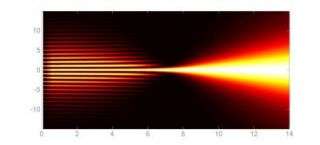New lens device will shrink huge light waves to pinpoints

Manipulating light waves, or electromagnetic radiation, has led to many technologies, from cameras to lasers to medical imaging machines that can see inside the human body.
Scientists at the University of Michigan have developed a way to make a lens-like device that focuses electromagnetic waves down to the tiniest of points. The breakthrough opens the door to the next generation of technology, said Roberto Merlin, professor of physics at U-M. His research on the discovery will be published online July 12 in Science Express.
Everywhere we go, we are surrounded by electromagnetic waves that are generated naturally, such as sunlight, and artificially, by appliances such as microwave ovens and radio transmitters. Some waves are visible, and some are invisible.
Materials respond differently to different wavelengths, and when using electromagnetic waves, one is usually limited by the length of the light wave, Merlin said. For example, the amount of information you can store on a CD is limited by the number of bits you can fit on the CD, and this is dictated by the length of the electromagnetic wave. The smaller the wavelength, the smaller the bit, which means more bits of data can be stored on the CD.
There is a huge push underway to find ways to get around this limitation, but until now scientists didn't have a good method for achieving that, Merlin said.
Using mathematical models, Merlin developed a formula that removes the wavelength limitation. Merlin is now working with assistant professor Anthony Grbic from the U-M College of Engineering to build the device, and they have filed for a patent.
The device will look like a plate or a disc, and is etched with a specific pattern. As the waves pass through the patterned lens, it is sculpted into different sizes and shapes. The lens does not refract, or bend the light waves---which is how conventional lenses work---but rather it reshapes the wave.
The discovery holds promise for applications in data storage, non-contact sensing, imaging, and nanolithography.
With the new technology, a CD could hold up to one hundred times more information by using terahertz radiation rather than visible light, even though the length of a terahertz wave is about 1000 times longer.
Source: University of Michigan




















